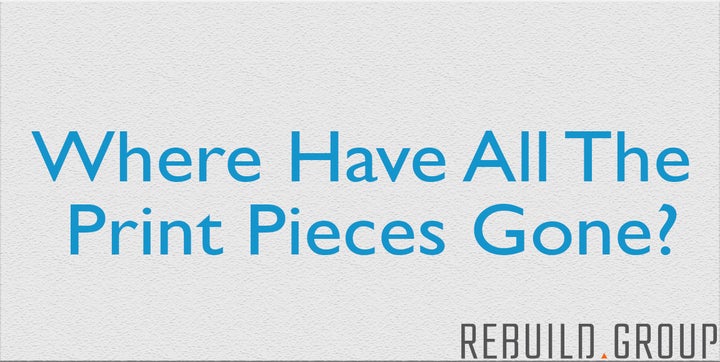A slice of today’s marketing landscape may seem like a washed-out snapshot of apps and microsites. What appears to be an industry devoid of print-piece campaigns is far from reality. We simply notice print less because most print-oriented strategies are not properly paired with digital and broadcast campaigns we do recognize.
Think about this: an industry-wide success metric for digital display ads is a 1% conversation rate. That’s right. 1% is a big deal. Your marketing campaign could do just as well or better by air-cannoning postcards at a Red Hot Chili Peppers concert.
Engagement is a tough metric to quantify when looking at print, and yet, the numbers from the 2016 DMA Fact Book suggest people are still engaging with print, and clients are still buying it. In 2015, 10.6 million print catalogs were mailed out and while direct mail volume itself may be declining, spend is up roughly 1.9 percent year-over-year since 2005.
So where does print work fit in?
Print fills a much-needed niche within content strategies and is generally higher-cost and higher impact than OLA (online advertising). Where online marketing is passive, direct mail is active. The trick is knowing how and when to use one to bolster the other, and using them in the same funnel to strengthen your brand rather than pull it apart.
Print publications make up for their limited reach through their ability to increase trustworthiness and clout. Where display ads can be one of hundreds seen by one user in a day, leafing through one print-piece from a single brand can create a more reliable, authentic connection.
But despite thinking about print in this way, many marketers struggle with the jump from print to digital—in particular, as they try to answer the question, “How does print bring my audience to the experience I’ve constructed on my website/social media/blog?”
But that’s not the right question to ask. The real question is, “How can print be A PART of the experience I’ve constructed online?”
Here are some powerful ways to utilize print to improve conversion and retention rates, right alongside awareness and visibility.
Augmented Reality
This is the ultimate meeting point of print and digital. The shopper gets more content from a direct mailing by using their phone to project a hologram that fits into the real world around them.
Voice Search
Use your direct mail pieces to incite curiosity. For instance, telling your consumers to ask a certain question to Amazon Alexa may cause them to engage based on interest in new technology. From there you can lead them to a digital experience that ties into a larger campaign.
Connect with Digital Leads
Use your online experience as an opt-in funnel for your mailings. That way you’re filtering out some of the waste and can invest more in the quality of your print work. It works as an extension of the journey by establishing an in-person connection with a customer you’ve already reached online.
Personalized URLs
Using Personalized, or tracking, URLs only found on specific print pieces allows you to gain actionable insights into who your customers are and who is willing to interact with your brand.
From In-Store to Social
Use your larger and more public print pieces as a way to generate social media conversations and/or include direct social engagements via touchscreen.
Google Voice Calling
An easier approach can be to set up a system of Google Voice numbers that all redirect to the same place. Assign each number to an individual piece of collateral, and you’ll get data on what is (or isn’t) performing—without the hassle of setting up new lines or asking callers for attribution.
Effective integration at the top of the funnel means coming up with an organic way for your audience to move online from print (or vice versa) while also implementing a way of tracking the specific actions that happen during that bridge.
You can also elaborate on your brand’s story by giving your customer something to hold that will help to nurture affinity.
The vast majority of companies don’t combine their online and offline marketing campaigns because they don’t really know where to start. Stand out from the competition by nailing the print/digital execution. Be the pioneer.
For more information on the best uses of print in advertising, contact our experts at Rebuild Group.

